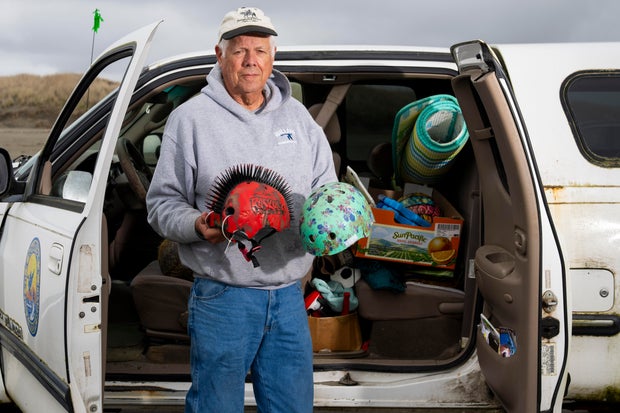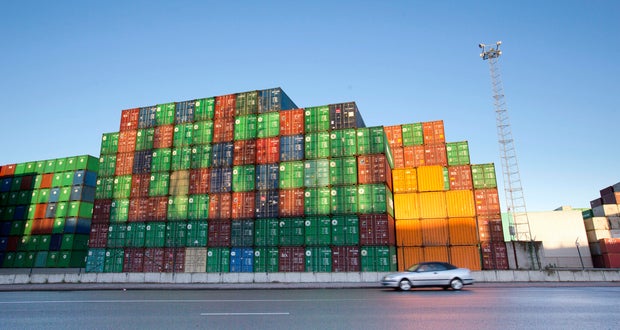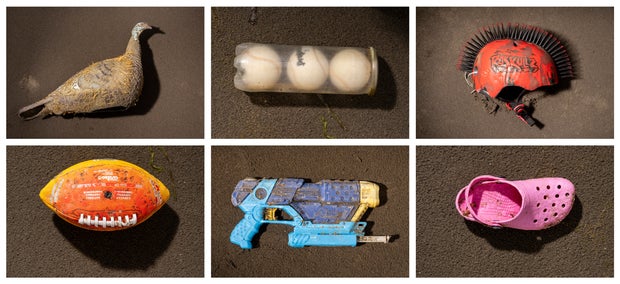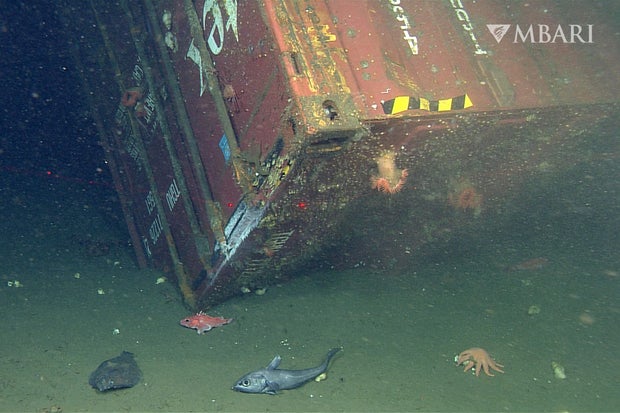CBS News
When shipping containers lost at sea burst open, what happens?

Russ Lewis has picked up some strange things along the coast of Long Beach Peninsula in Washington state over the years: Hot Wheels bicycle helmets with feather tufts, life-size plastic turkey decoys made for hunters, colorful squirt guns.
And Crocs — so many mismatched Crocs.
If you find a single Croc shoe, you might think somebody lost it out on the beach, he said. “But, if you find two, three, four and they’re different — you know, one’s a big one, one’s a little one — that’s a clue.”
These items aren’t like the used fishing gear and beer cans that Lewis also finds tossed overboard by fishers or partygoers. They’re the detritus of commercial shipping containers lost in the open ocean.
Lindsey Wasson / AP
Most of the world’s raw materials and everyday goods that are moved over long distances — from T-shirts to televisions, cellphones to hospital beds — are packed in large metal boxes the size of tractor-trailers and stacked on ships. A trade group says some 250 million containers cross the oceans every year — but not everything arrives as planned.
More than 20,000 shipping containers have tumbled overboard in the last decade and a half. Their varied contents have washed onto shorelines, poisoned fisheries and animal habitats, and added to swirling ocean trash vortexes. Most containers eventually sink to the sea floor and are never retrieved.
Virginia Mayo / AP
Cargo ships can lose anywhere from a single container to hundreds at a time in rough seas. Experts disagree on how many are lost each year. The World Shipping Council, an industry group, reports that, on average, about 1,500 were lost annually over the 16 years they’ve tracked — though fewer in recent years. Others say the real number is much higher, as the shipping council data doesn’t include the entire industry and there are no penalties for failing to report losses publicly.
Much of the debris that washed up on Lewis’ beach matched items lost off the giant cargo ship ONE Apus in November 2020. When the ship hit heavy swells on a voyage from China to California, nearly 2,000 containers slid into the Pacific.
Court documents and industry reports show the vessel was carrying more than $100,000 worth of bicycle helmets and thousands of cartons of Crocs, as well as electronics and other more hazardous goods: batteries, ethanol and 54 containers of fireworks.
Lindsey Wasson / AP
Researchers mapped the flow of debris to several Pacific coastlines thousands of miles apart, including Lewis’ beach and the remote Midway Atoll, a national wildlife refuge for millions of seabirds near the Hawaiian Islands that also received a flood of mismatched Crocs.
Scientists and environmental advocates say more should be done to track losses and prevent container spills.
“Just because it may seem ‘out of sight, out of mind,’ doesn’t mean there aren’t vast environmental consequences,” said marine biologist Andrew DeVogelaere of California’s Monterey Bay National Marine Sanctuary, who has spent more than 15 years studying the environmental impact of a single container that was found in sanctuary waters.
“We are leaving time capsules on the bottom of the sea of everything we buy and sell — sitting down there for maybe hundreds of years,” he said.
This year’s summer winds washed thousands of plastic pellets ashore near Colombo, Sri Lanka, three years after a massive fire aboard the X-Press Pearl burned for days and sank the vessel a few miles offshore.
The disaster dumped more than 1,400 damaged shipping containers into the sea — releasing billions of plastic manufacturing pellets known as nurdles as well as thousands of tons of nitric acid, lead, methanol and sodium hydroxide, all toxic to marine life.
Hemantha Withanage remembers how the beach near his home smelled of burnt chemicals. Volunteers soon collected thousands of dead fish, gills stuffed with chemical-laced plastic, and nearly 400 dead endangered sea turtles, more than 40 dolphins and six whales, their mouths jammed with plastic. “It was like a war zone,” he said.
Cleanup crews wearing full-body hazmat suits strode into the tide with hand sieves to try to collect the lentil-size plastic pellets.
The waterfront was closed to commercial fishing for three months, and the 12,000 families that depend on fishing for their income have only gotten a fraction of the $72 million that Withanage, founder of Sri Lanka’s nonprofit Centre for Environmental Justice, believes they are owed.
“Just last week, there was a huge wind, and all the beaches were full of plastic again,” he said in mid-June.
Lost container contents don’t have to be toxic to wreak havoc.
In February, the cargo ship President Eisenhower lost 24 containers off the central California coast. Some held bales of soon-waterlogged cotton and burst open. Debris washed ashore near Monterey Bay National Marine Sanctuary, a federally protected area.
The ship’s captain informed the U.S. Coast Guard, which worked with the National Oceanic and Atmospheric Administration and California State Parks to remove the debris. Each bale was too heavy to drag away — instead they had to be cut up, each filling two dump trucks.
“A rancid soggy mess,” said Eric Hjelstrom, a chief ranger for California State Parks. “If tidal pools get filled with cotton, that can block out sunlight and harm a lot of organisms.”
One bale landed in an elephant seal nursery, surrounded by baby seals. “You have to be careful how to approach it – you don’t want to injure the seals,” Hjelstrom said. A marine mammal specialist gently escorted 10 pups away before the bale was removed.
Although the operators of the President Eisenhower helped pay for cleanup, neither California nor federal authorities have ordered the company to pay any penalties.
As for the metal shipping containers, only one was spotted on a U.S. Coast Guard overflight, and it had vanished from sight by the time a tugboat was sent to retrieve it, said Coast Guard Lt. Chris Payne in San Francisco.
When shipping containers are lost overboard, “Most of them sink. And a lot of times, they’re just in really deep water,” said Jason Rolfe of NOAA’s Marine Debris Program.
/ AP
Most sunken containers — some still sealed, some damaged and open — are never found or recovered.
The Coast Guard has limited powers to compel shipowners to retrieve containers unless they threaten a marine sanctuary or contain oil or designated hazardous materials. “If it’s outside our jurisdiction,” said Payne, “there’s nothing that we can do as the federal government to basically require a company to retrieve a container.”
The long-term impact of adding on average more than a thousand containers each year to the world’s oceans — by the most conservative estimates — remains unknown.
Scientists at Monterey Bay Aquarium Research Institute in California are studying the cascade of changes wrought by a single container found by chance on the seabed.
Their research team was operating a remote-control vehicle at 4,200 feet (1,280 meters) below the surface to study deep-sea corals in 2004 when they were surprised to encounter a metal box. “It’s just serendipity that we found it,” said marine ecologist Jim Barry. Despite multiple spills in nearby shipping lanes, “It’s the only container that we know exactly where it landed.”
“The first thing that happens is they land and crush everything underneath them,” said DeVogelaere, who studied the sunken container. By changing the flow of water and sediment, the container completely changes the micro-ecosystem around it — impacting seafloor species that scientists are still discovering.
“The animals in the deep have felt our presence before we even knew anything about them,” he said.
Labels showed the container came from the Med Taipei, which had lost two dozen boxes in rough seas on a journey between San Francisco and Los Angeles. In 2006, the ship owners and operators reached a settlement with the U.S. Department of Justice to pay $3.25 million for estimated damages to the marine environment.
More than 80% of international trade by volume arrives by sea. All this cargo travels on increasingly vast ships.
“On the modern big ships, it’s like a high-rise building,” said Jos Koning, a senior project manager at MARIN, a Netherlands-based maritime research organization that studies shipping risks.
Today’s largest cargo vessels are longer than three football fields, with cranes required to lift containers and stack them in towering columns. When the industry took off some 50 years ago, ships could hold only about a tenth of the freight that today’s behemoths carry. According to the insurer Allianz, container ship capacities have doubled in just the last two decades.
Greater size brings heightened risks. The largest ships are more difficult to maneuver and more prone to rolling in high waves. And there’s a greater chance that any single box could be damaged and crushed — a destabilizing accident that can send an entire stack of containers cascading into the sea.
In February, the marine insurer Gard published a study based on six years of their claims that showed 9% of ultra-large ships had experienced container losses, compared to just 1% of smaller vessels.
Accidents are often linked to cargo that has been inaccurately labeled, weighed or stored. Investigators determined that the X-Press Pearl’s devastating spill near Sri Lanka, for instance, was the result of a fire that likely started from a poorly stacked container that was leaking nitric acid.
But cargo ship operators don’t have the capacity to verify all container weights and contents, and instead must rely on information that shippers provide.
“It’s just completely impractical to think that you can open every container,” said Ian Lennard, president of the National Cargo Bureau, a nonprofit that works with the U.S. Coast Guard to inspect seagoing cargo.
In a pilot study, the group found that widespread mislabeling and improper stowage meant that nearly 70% of shipping containers arriving in the U.S. with dangerous goods failed the bureau’s safety inspection.
“Despite all these problems, most of the time it arrives safely,” Lennard said.
But when there is a crisis — a ship hits rough weather, or a container carrying a chemical ignites in summer heat — accidents can have catastrophic impacts.
How often do shipping container spills happen? There’s no clear answer.
Existing tracking efforts are fragmented and incomplete. Although a few shipwrecks and disasters grab headlines, like the March crash of a cargo ship into a Baltimore bridge, much less is known about how often containers are lost piecemeal or away from major ports.
To date, the most widely cited figures on lost shipping containers come from the World Shipping Council. The group’s membership, which carries about 90% of global container traffic, self-reports their losses in a survey each year.
Over 16 years of collected data through 2023, the group said an average of 1,480 containers were lost annually. Their recent figures show 650 containers were lost in 2022 and only about 200 last year.
Elisabeth Braw, senior fellow with the Atlantic Council’s Transatlantic Security Initiative, said self-reported surveys miss the full picture.
For example, not included in the 2023 tally were 1,300 containers from the cargo ship Angel, which sank near Taiwan’s Kaohsiung port. That’s because the ship’s operators aren’t members of the World Shipping Council.
Lloyd’s List Intelligence, a maritime intelligence company that’s tracked thousands of marine accidents on container ships over the past decade, told AP that underreporting is rampant, saying ship operators and owners want to avoid insurance rate hikes and protect their reputations.
Marine insurers, which are typically on the hook to pay for mishaps, likely have access to more complete data on losses – but no laws require that data to be collected and shared publicly.
World Shipping Council president and CEO Joe Kramek said the industry is researching ways to reduce errors in loading and stacking containers, as well as in navigating ships through turbulent waters.
“We don’t like when it (a container loss) happens,” said Kramek. “But the maritime environment is one of the most challenging environments to operate in.”
Earlier this year, the United Nations’ International Maritime Organization adopted amendments to two global ocean treaties aimed at increasing transparency around lost shipping containers. Those changes, expected to take effect in 2026, will require ships to report losses to nearby coastal countries and to authorities where the vessel is registered.
But with no enforceable penalties, it remains to be seen how extensively operators will comply.
Alfredo Parroquín-Ohlson, head of cargo in the IMO’s maritime safety division, said, “We just encourage them and tell them how important it is, but we cannot be a police.”
It’s not just environmentalists who worry. Some lost containers float for days before sinking — endangering boats of all sizes, from commercial vessels to recreational sailboats.
The sporting body World Sailing has reported at least eight instances in which crews had to abandon boats because of collisions with what were believed to be containers. In 2016, sailor Thomas Ruyant was 42 days into a race around the world when his sailboat’s hull split from a sudden crash with what appeared to be a floating container.
“It gives me the shivers just thinking about it,” he said in a video dispatch from his damaged boat as he steered toward shore.
In Sri Lanka, the consequences of the X-Press Pearl accident linger, three years after the ship went down.
Fishermen have seen stocks of key species shrink, and populations of long-lived, slow-reproducing animals such as sea turtles may take several generations to recover.
For his part, Lewis, the volunteer beach cleaner in Washington state, said he wonders about all the debris he doesn’t see wash up on his shores.
“What’s going to happen when it gets down deep and, you know, it just ruptures?” he said. “We know we’ve got a problem on the surface, but I think the bigger problem is what’s on the seafloor.”
___
Larson and Wieffering reported from Washington, D.C. Bharatha Mallawarachi contributed reporting from Colombo, Sri Lanka.
___
This story was supported by funding from the Walton Family Foundation and the Howard Hughes Medical Institute’s Science and Educational Media Group. The AP is solely responsible for all content.
CBS News
How to watch the Detroit Lions vs. Indianapolis Colts NFL game today: Livestream options, more

Nic Antaya/Getty Images
The Detroit Lions will face off against the Indianapolis Colts today. The Lions enter this game as top contenders with a near-perfect record of 9-1 so far this season. The Colts, who are 5-6 this season, could have a tough game on their hands against the Lions but will be looking to rack up another win after prevailing over the New York Jets in a tight game last Sunday.
Here’s how and when you can watch the Colts vs. Lions game today, whether or not you have cable.
Here’s how and when to watch the Detroit Lions vs. Indianapolis Colts
The Lions vs. Colts game will be played on Sunday, November 24, 2024 at 1:00 p.m. ET (11:00 a.m. PT). The game will air on Fox and stream on Fubo and the platforms featured below.
How and when to watch the Detroit Lions vs. Indianapolis Colts game without cable
You can watch this week’s NFL game on Fox via several streaming services. All you need is an internet connection and one of the top options outlined below.
Experience NFL action like never before with Fubo’s comprehensive sports streaming platform. From Sunday showdowns to primetime matchups, catch every NFL game across major networks including CBS, Fox, NBC, ABC, ESPN and NFL Network. Choose the Pro package to unlock 200+ channels and limitless DVR storage, or elevate your game-day experience with the Elite with Sports Plus package, featuring NFL RedZone’s commercial-free scoring highlights and stunning 4K quality.
Test drive the service with a no-commitment seven-day free trial, and share the excitement with family and friends — Fubo supports simultaneous streaming on up to 10 devices, so everyone can watch their favorite teams.
You can watch today’s game with a subscription to Sling’s Orange + Blue tier, which includes ESPN, ABC, NBC, and Fox. The plan offers 46 channels with local NFL games, nationally broadcast games, and 50 hours of DVR storage. For complete NFL coverage, add Paramount+ to get CBS games, or upgrade with the Sports Extra add-on for additional sports channels like Golf Channel, NBA TV and NFL RedZone.
Watching NFL games, including Fox broadcasts, is simple with Hulu + Live TV, which includes 90 channels, unlimited DVR storage, and access to NFL preseason games, live regular season games and studio shows. The service includes ESPN+ and Disney+ in the subscription.
Want to watch today’s game live on your smartphone? If so, NFL+ streaming service is the solution you’re looking for. It lets you watch NFL Network and out-of-market games on mobile devices, with an upgrade option to NFL+ Premium that includes NFL RedZone for watching up to eight games simultaneously. Note that NFL+ only works on phones and tablets, not TVs.
CBS News
How to watch the New England Patriots vs. Miami Dolphins NFL game today: Livestream options, more

Getty Images
The New England Patriots will face off against the Miami Dolphins in a game today at the Hard Rock Stadium in Miami. The Patriots have had an uneven season so far, coming into the game with a record of 3-8, including a 28-22 loss to the Los Angeles Rams on November 17. The Dolphins, however, haven’t fared much better this season as they enter the game with a record of 4-6, although they are coming off two wins in a row, the latest against the Las Vegas Raiders last weekend.
Keep reading to find out how and when to watch the New England Patriots vs. Miami Dolphins game today, even without cable.
CBS, Paramount+ and CBS Essentials are all subsidiaries of Paramount Global.
How and when to watch the New England Patriots vs. Miami Dolphins game today
The New England Patriots vs. Miami Dolphins game will be played on Sunday, November 24, 2024 at 1:00 p.m. ET (10:00 a.m. PT). The football game will be shown on CBS and streamed on Paramount+ and the platforms noted below.
How and when to watch the New England Patriots vs. Miami Dolphins game without cable
While CBS is available with many basic cable packages, you’ll have other viewing options, too for the Patriots-Dolphins game. Just understand that the below streaming options will require the use of an internet provider:
Paramount+: Watch CBS-aired NFL games without cable
With Paramount+ you’ll have multiple viewing options to choose from. You can catch NFL games on the Paramount+ Essential tier for just $7.99 each month or you can watch college football with a Paramount+ with Showtime subscription for $12.99 monthly. In addition to live streams of NFL games airing on CBS, you’ll get to watch additional live sporting events including NCAA college football, PGA Tour golf, soccer and more.
Get started with Paramount+ here today.
Amazon Prime Video: Add Paramount+ to your existing subscription
Already have an Amazon Prime Video account? Simply add Paramount+ to your current subscription to watch all the CBS-aired NFL games in addition to Paramount+ originals. The same prices from above apply, depending on which tier you choose. Not sure which is best for you? Don’t worry. Both options come with a free seven-day trial that can help you decide.
Watch the Patriots-Dolphins game on Amazon Prime Video.
Fubo: Watch the Patriots-Dolphins game for free
Looking for an inexpensive way to watch football? Fubo could be the best way to do so. The live TV streamer is currently offering a seven-day free trial and $30 off of your first month’s subscription. Once subscribed, you’ll gain access to all of their live sporting events immediately. And there will be a lot to choose from. Not only does Fubo come with access to NFL games airing on your local CBS channel, it also includes Fox Sunday NFC games, “Sunday Night Football” on NBC, “Monday Night Football” on ABC and ESPN and all of the games that air on the NFL Network. So don’t wait.
Get started with Fubo online now.
CBS News
How to watch the Tampa Bay Buccaneers vs. New York Giants NFL game today: Livestream options, more

Kevin Sabitus/Getty Images
MetLife Stadium in New Jersey is set to host a game between the Tampa Bay Buccaneers and the New York Giants today. Both teams have lost more games than they’ve won so far this season. The Buccaneers enter the game looking to end a four-game losing streak. Overall, they’re just 4-6 while the Giants are 2-8, having lost five consecutive games.
Keep reading to find out how and when to watch the Tampa Bay Buccaneers vs. New York Giants game today, even without cable.
CBS, Paramount+ and CBS Essentials are all subsidiaries of Paramount Global.
How and when to watch the Tampa Bay Buccaneers vs. New York Giants game today
The Tampa Bay Buccaneers vs. New York Giants game will be played on Sunday, November 24, 2024 at 1:00 p.m. ET (10:00 a.m. PT). The NFL game will be televised on CBS. It can also be streamed on Paramount+ and the platforms noted below.
How and when to watch the Tampa Bay Buccaneers vs. New York Giants game without cable
While CBS is available with many basic cable packages, you’ll have other viewing options, too for the big game. Just note that the below streaming options will require the use of an internet provider:
Paramount+: Watch CBS-aired NFL games without cable
With Paramount+ you’ll have multiple viewing options to choose from. You can catch NFL games on the Paramount+ Essential tier for just $7.99 each month or you can watch college football with a Paramount+ with Showtime subscription for $12.99 monthly. In addition to live streams of NFL games airing on CBS, you’ll get to watch additional live sporting events including NCAA college football, PGA Tour golf, soccer and more.
Get started with Paramount+ here today.
Amazon Prime Video: Add Paramount+ to your existing subscription
Already have an Amazon Prime Video account? Then you can simply add Paramount+ to your current subscription to watch all the CBS-aired NFL games in addition to Paramount+ originals. The same prices from above apply, depending on which tier you choose. Not sure which is best for you? Don’t worry. Both options come with a free seven-day trial that can help you decide.
Watch the Buccaneers-Giants game on Amazon Prime Video.
Fubo: Watch the Buccaneers-Giants game for free
Looking for an inexpensive way to watch football? Fubo could be the best way to do so. The live TV streamer is currently offering a seven-day free trial and $30 off of your first month’s subscription. Once subscribed, you’ll gain access to all of their live sporting events immediately. And there will be a lot to choose from. Not only does Fubo come with access to NFL games airing on your local CBS channel, it also includes Fox Sunday NFC games, “Sunday Night Football” on NBC, “Monday Night Football” on ABC and ESPN and all of the games that air on the NFL Network. So don’t wait.
Get started with Fubo online now.














